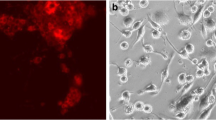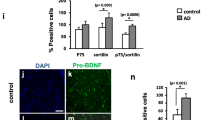Abstract
Used in this work are PC12 cells transfected with human gene expressing amyloid-precursor protein of β-peptide and carrying the so-called “Swedish mutation” leading to the appearance of one of Alzheimer’s disease family forms. It has been shown that the PC12 cells transfected with this mutant gene, at action of various hydrogen peroxide concentrations, die to the significant greater degree than the used for comparison PC12 cells transfected with analogous human gene of the wild type or than vector-transfected cells. It has been found that ganglioside GM1 at micro-or nanomolar concentrations is able to increase viability of the PC12 cells transfected with the mutant gene causing a significant accumulation of endogenous amyloid β-peptide. The obtained data confirm an important role of oxidative stress in injury and death of brain nerve cells in Alzheimer’s disease.
Similar content being viewed by others
References
Martin, B.L., Schrader-Fisher, G., Husciglin, J., Duke, M., Paganetti, P., and Yankner, B.A., Intracellular Accumulation of β-Amyloid in Cells Expressing the Swedish Mutant Amyloid Precursor Protein. J. Biol. Chem., 1995, vol. 270, pp. 26 727–26 730.
Perez, R.G., Squazzo, S.L., and Koo, E.H., Enhanced Release of Amyloid β-Protein from Codon 670/671 “Swedish” Mutant β-Amyloid Precursor Protein Occurs in Both Secretary and Endocytic Pathways. J. Biol. Chem., 1995, vol. 271, pp. 9100–9107.
Brouwers, S., Sleegers, K., Engelborghs, S., Bogaerts, Y., Serneels, S., Kamali, K., Corsmit, E., de Leemheir, E., Martin, J.J., de Dein, P.P., Broeckhoven, C., and van’ Theuns, J., Genetic Risk and Transcriptional Variability of Amyloid Precursor Protein in Alzheimer’s Disease, Brain, 2006, vol. 129, pp. 2984–2991.
Vetrivel, K.S., Zhang, Y.W., Xu, H., and Thinakaran, G., Pathological and Physiological Functions of Presenilins, Molec. Neurodegener., 2006, vol. 1, p. 4.
Carter, D.B., Dunn, E., McKinley, D.D., Stratman, N.C., Boyle, T.P., Kulper, S.L., Oostveen, J.A., Weaver, R.J., Bolter, J.A., and Gurney, M.E., Human Apolipoprotein E4 Accelerates Beta-Amyloid Deposition in APP SW Transgenic Mouse Brain, Ann. Neurol., 2001, vol. 50, pp. 468–475.
Gau, J.T., Steinhilb, M.L., Kao, T.C., D’Amato, C.J., Gaut, J.R., Frey, K.A., and Turner, R.S., Stable Beta-Secretase Activity and Presynaptic Cholinergic Markers during Progressive Central Nervous System Amyloidogenesis in Tg2576 Mice, Am. J. Pathol., 2002, vol. 160, pp. 731–738.
Marques, C., Keil, U., Bonert, A., Steiner, B., Haass, C., Muller, W.E., and Eckert, A., Neurotoxic Mechanisms Caused by Alzheimer’s Disease-Linked Swedish Amyloid Precursor Protein Mutation, J. Biol. Chem., 2003, vol. 278, pp. 28 294–28 302.
Matsuoki, Y., Saito, M., LaFrancois, J., Saito, M., Gaynor, K., Olm, V., Wang, L., Casey, E., Lu, Y., Shiratori, C., Lemere, C., and Duff, K., Novel Therapeutic Approach for the Treatment of Alzheimer’s Disease by Peripheral Administration of Agents with Affinity to Beta Amyloid, J. Neurosci., 2003, vol. 23, pp. 29–33.
Eckert, A., Steiner, B., Marques, C., Leutz, S., Roming, H., Haass, C., and Muller, W.E., Elevated Vulnerability to Oxidative Stress-Induced Cell Death and Activation of Caspase-3 by the Swedish Amyloid Precursor Protein Mutation, J. Neurochem. Res., 2001, vol. 64, pp. 183–192.
Fighera, M.R., Bonini, J.S., de Oliveira, T.G., Frussa-Filho, R., Rocha, J.B., Dutra-Filho, C.S., Rubin, M.A., and Mello, C.F., GM 1 Ganglioside Attenuates Convulsions and Thiobarbituric Acid Reactive Substances Production Induced by Intrastriatal Injection of Methylmalonic Acid, Int. J. Biochem. Cell Biol., 2003, vol. 35, pp. 465–473.
Choi, J.S., Kim, J.A., and Joo, C.K., Activation of MAPK and CREB by GM1 Induces Survival of RGCs in the Retina with Axotomized Nerve, Invest. Ophthalmol. Vis. Sci., 2003, vol. 44, pp. 1747–1752.
Bachis, A. and Mocchetti, I., Semisynthetic Sphingoglycolipid LIGA20 Is Neuroprotective Against Human Immunodeficiency Virus-gp120-Mediated Apoptosis, J. Neurosci. Res., 2006, vol. 83, pp. 890–896.
Hadjiconstantinou, M. and Neff, N.H., GM1 Ganglioside: in vivo and in vitro Trophic Actions on Central Neurotransmitter Systems, J. Neurochem., 1998, vol. 70, pp. 1335–1345.
Avrova, N.F., Victorov, I.V., Tyurin, V.A., Zakharova, I.O., Sokolova, T.V., Andreeva, N.A., Stelmaschuk, E.V., Tyurina, Y.Y., and Gonchar, V.S., Inhibition of Glutamate-Induced Intensification of Free Radical Reactions by Gangliosides: Possible Role in Their Protective Effect in Rat Cerebellar Granule Cells and Brain Synaptosomes, Neurochem. Res., 1998, vol. 23, pp. 945–952.
Mahadik, S.P., Bharucha, V.A., Stadlin, A., Ortiz, A., and Karpiak, S.E., Loss and Recovery of Activities of α+ and α Isozymes of Na+, K+-AT-Pase in Cortical Focal Ischemia: GM1 Ganglioside Protects Plasma Membrane Structure and Functions, J. Neurosci. Res., 1992, vol. 32, pp. 209–220.
Sautter, J., Hoglinger, G.U., Oertel, W.H., and Earl, C.D., Systemic Treatment with GM1 Ganglioside Improve Survival and Function of Cryopreserved Embryonic Midbrain Grafted to the 6-Hydroxydopamine-Lesioned Striatum, Exp. Neurol., 2000, vol. 164, pp. 121–129.
Augustinsson, L.E., Blennow, K., Blomstrand, C., and Brane, G., Intracerebroventricular Administration of GM1 Ganglioside in Presenile Alzheimer’s Disease, Dement. Geriatr. Gogn. Disord., 1997, vol. 8, pp. 26–33.
Schneider, J.S., Roeltgen, D.P., Mancall, E.L. Chapas-Crilly, J., Rothblat, D.S., and Tatarian, G.T., Parkinson’s Disease: Improved Function with GM1 Ganglioside Treatment in a Randomized Placebo-Controlled Study, Neurology, 1998, vol. 50, pp. 1630–1636.
Svennerholm, L., Brane, G., Karlsson, I., Lekman, A., Ramstrom, I., and Wikkelso, C., Alzheimer’s Disease-Effect of Continuous Intracerebroventricular Treatment with GM1 Ganglioside and a Systematic Activation Programme, Dement. Geriatr. Cogn. Disord., 2002, vol. 14, pp. 128–136.
Pope-Coleman, A. and Schneider, J.S., Effect of Chronic GM1 Ganglioside Treatment on Cognitive and Motor Deficits in a Slowly Progressing Model of Parkinsonism in Non-Human Primates, Restor. Neurol. Neirosci., 1998, vol. 12, pp. 255–266.
Vassault, A., Lactate Dehydrogenase: UV-Method with Pyruvate and NADH, Methods of Enzymatic Analysis, Bergmeyer, H.U., Ed., Weinheim: Verlag Chemie, 1983, vol. 3, pp. 118–126.
Folch, J., Lees, M., and Sloan-Stanley, G.H., A Simple Method for Isolation and Purification of Total Lipids from Animal Tissue, J. Biol. Chem., 1957, vol. 226, pp. 497–509.
Tyurin, V.A., Tyurina, Yu.Yu., and Avrova, N.F., Ganglioside-Dependent Factor, Inhibiting Lipid Peroxidation in Rat Brain Synaptosomes, Neurochem. Int., 1992, vol. 20, pp. 401–407.
Eckert, A., Marques, C., Keil, U., Schussel, K., and Muller, W.E., Increased Apoptotic Cell Death in Sporadic and Genetic Alzheimer’s Disease, Ann. N. Y. Acad. Sci., 2003, vol. 1010, pp. 604–609.
Sokolova, T.V., Furaev, V.V., Yurlova, L.A., and Avrova, N.F., Effect of GM1 Ganglioside on Intracellular Concentration of Free Calcium and Viability of PC12 Cells at Induction of Oxidative Stress, Neurokhimiya, 2005, vol. 22, no. 4, pp. 266–272.
Avrova, N.F., Zakharova, I.O., Tyurin, V.A., Tyurina, Y.Y., Gamaley, I.A., and Schepetkin, I.A., Different Metabolic Effects of Ganglioside GM1 in Brain Synaptosomes and Phagocytic Cells, Neurochem. Res., 2002, vol. 27, pp. 751–759.
Fighera, M.R., Bonini, J.S., Frussa-Filho, R., Dutra-Filho, C.S., Hagen, M.F., Rubin, M.A., and Mello, C.F., Monosialoganglioside Increases Catalase Activity in Cerebral Cortex of Rats, Free Radic. Res., 2004, vol. 38, pp. 495–500.
Author information
Authors and Affiliations
Additional information
Original Russian Text © T. V. Sokolova, I. O. Zakharova, V. V. Furaev, M. P. Rychkova, N. F. Avrova, 2008, published in Zhurnal Evolyutsionnoi Biokhimii i Fiziologii, 2008, Vol. 44, No. 1, pp. 26–31.
Rights and permissions
About this article
Cite this article
Sokolova, T.V., Zakharova, I.O., Furaev, V.V. et al. PC12 cells transfected with human mutant gene causing one of Alzheimer’s disease forms have a high sensitivity to oxidative stress. J Evol Biochem Phys 44, 29–35 (2008). https://doi.org/10.1134/S0022093008010040
Received:
Published:
Issue Date:
DOI: https://doi.org/10.1134/S0022093008010040




